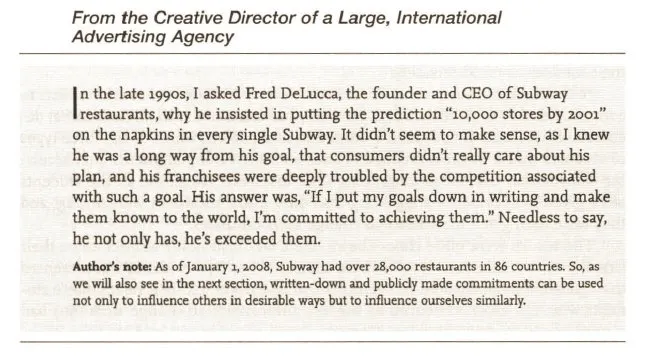
Psychologists have long understood the power of the consistency principle to direct human action. As Cialdini (2009) noted, The drive to be (and look) consistent constitutes a highly potent weapon of social influence, often causing us to act in ways that are clearly contrary to our own best interest.
To understand why consistency is so powerful a motive, we should recognize that, in most circumstances, consistency is valued and adaptive. As such, Inconsistency is commonly thought to be an undesirable personality trait. The person whose beliefs, words, and deeds don't match is seen as confused, two-faced, even mentally ill. On the other side, a high degree of consistency is normally associated with personal and intellectual strength. It is the heart of logic, rationality, stability, and honesty.
Consistency is highly valued in our culture. We fall into the habit of being automatically consistent even in situations where it is not the sensible way to be. When it occurs unthinkingly, consistency can be disastrous. Once we have made up our minds about issues, stubborn consistency allows us a very appealing luxury: We don't have to think hard about the issues anymore. We don't really have to sift through the blizzard of information we encounter every day to identify relevant facts; we don't have to expend the mental energy to weigh the pros and cons; we don't have to make any further tough decisions. Instead, all we have to do when confronted with the issues is click on our consistency tape, whirr, and we know just what to believe, say, or do. We need only believe, say, or do whatever is consistent with our earlier decision.

It is important to note that automatic consistency functions as a shield against thought, it should not be surprising that such consistency can also be exploited by those who would prefer that we respond to their requests without thinking.

For the manipulator - If I can get you to make a commitment (that is, to take a stand, to go on record), I will have set the stage for your automatic and ill-considered consistency with that earlier commitment. In addition, procedures designed to create commitment take various forms. Some are bluntly straightforward; others are among the most subtle compliance tactics we will encounter.

Consider the documented historical case illustrated by Cialdini:
During the Korean War, many captured American soldiers found themselves in prisoner-of-war camps run by the Chinese Communists. It became clear early in the conflict that the Chinese treated captives quite differently than did their allies, the North Koreans, who favored harsh punishment to gain compliance. Specifically avoiding the appearance of brutality, the Red Chinese engaged in what they termed their "lenient policy," which was, in reality, a concerted and sophisticated psychological
assault on their captives. After the war, American psychologists questioned the returning prisoners intensively to determine what had occurred, in part because of the unsettling success of some aspects of the Chinese program.
For example, the Chinese were very effective in getting Americans to inform on one another, in striking contrast to the behavior of American POWs in World War II. For this reason, among others, escape plans were quickly uncovered and the escapes themselves almost always unsuccessful. "When an escape did occur," wrote psychologist Edgar Schein (1956), a principal American investigator of the Chinese indoctrination offering a bag of rice to anyone turning him in." In fact, nearly all American prisoners in the Chinese camps are said to have collaborated with the enemy in one way or another. An examination of the prison-camp program shows that the Chinese relied heavily on commitment and consistency pressures to gain the desired compliance from their captives.
Winning of Hearts & Minds
You can use small commitments to manipulate a person's self-image; you can use them to turn citizens into "public servants," prospects into "customers," prisoners into "collaborators." Once you've got a person's self-image where you want it, that person should comply naturally with a whole range of requests that are consistent with this new self-view. In regards to POW's, the major intent of the Chinese was not simply to extract information from their prisoners. It was to indoctrinate them, to change their attitudes and perceptions of themselves, of their political system, of their country's role in the war, and of communism.

Dr. Henry Segal, chief of the neuropsychiatric evaluation team that examined returning POWs at the end of the Korean War, reported that war-related beliefs had been substantially:
Many expressed antipathy toward the Chinese Communists but at the same time praised them for "the fine job they had done in China." Others stated that "although communism won't work in America, I think it's a good thing for Asia."
(Segal, 1954, p. 360)
In addition, Whenever one takes a stand that is visible to others, there arises a drive to maintain that stand in order to look like a consistent person.

It is important to realize that we must be wary of the tendency to be automatically and unthinkingly consistent, for it lays us open to the maneuvers of those who want to exploit the mechanical commitment-consistency sequence for profit. The only way out of the dilemma is to know when such consistency is likely to lead to a poor choice. As Cialdini (2009) notes, "I don't try to deny the importance of consistency; I just point out the absurdity of foolish consistency."
Finally, in individualistic nations such as the United States and those of Western Europe, the focus is on the self, whereas, in more collectivistic societies, the focus is on the group. Individualists decide what they should do in a situation by looking primarily at their own histories, opinions, and choices rather than those of their peers. This should make them highly vulnerable to influence tactics that use as leverage what a person has previously said or done. Thus, members of individualistic societies-particularly older members-need to be alert to influence tactics that begin by requesting just a small step. Those small, cautious steps can lead to big, blind leaps.
In conclusion as Cialdini correctly identified, commitment and consistency tactics are likely to work especially well on members of individualistic societies, particularly those who are over 50 years old.
Reference:
Cialdini, R. 2009. Influence: Science and Practice. Boston: Pearson.